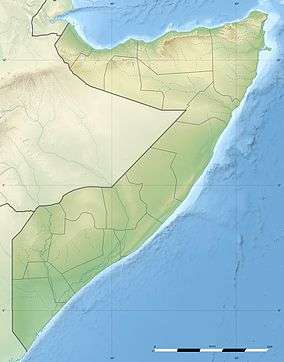Hobyo
Hobyo (Somali: Hobyo, also known as Obbia in Italian), is an ancient port city in Galmudug state in the north-central Mudug region of Somalia. Hobyo serves as the main port of Galmudug State.
Hobyo هوبيو Obbia | |
|---|---|
city | |
 Hobyo Location in Somalia | |
| Coordinates: 5°21′05″N 48°31′32″E | |
| Country | |
| Region | Mudug |
| District | Hobyo |
| Government | |
| • Type | District Council |
| • mayor | Abdulahi Ali Fatax[1] |
| Population | |
| • Total | 11,800 |
| Time zone | UTC+3 (EAT) |
Hobyo developed as a coastal outpost by the Ajuran Empire during the 13th century.[2] In the late 17th century the Hiraab successfully revolted against the Ajuran Sultanate who had been ruling Hobyo since the 13th century and established an independent Hiraab Imamate. [3] According to Dr. Bernhard Helander of Uppsala University, "the Imam of Hiraab is a hereditary position that traditionally is held by a person of the first-born branch."[4]
.[5]
History
Ajuuran Empire Period
Along with Mareeg, Hobyo developed as a coastal outpost by the Ajuran Empire during the 13th century.[2]
However, in the late 17th century the Hiraab successfully revolted against the Ajuran Sultanate and established an independent Hiraab Imamate[3] According to Dr. Bernhard Helander of Uppsala University, "the Imam of Hiraab is a hereditary position that traditionally is held by a person of the first-born branch."[4]
Lee Cassanelli in his book The Shaping of Somali society provides a historical picture of the Hiraab Immate. He writes:
"According to local oral tradition, the Hiraab imamate was a powerful alliance of closely related groups who shared a common lineage under the Gorgaarte clan divisions. It successfully revolted against the Ajuran Sultanate and established an independent rule for at least two centuries from the seventeen hundreds and onwards.[3]
The alliance involved the army leaders and advisors of the Habar Gidir and Duduble, a Fiqhi/Qadi of Sheekhaal, and the Imam was reserved for the Mudulood branch who is believed to have been the first born. Once established, the Imamate ruled the territories from the Shabeelle valley, the Benaadir provinces, the Mareeg areas all the way to the arid lands of Mudug[3]
The agricultural centres of Eldher and Harardhere included the production of sorghum and beans, supplementing with herds of camels, cattle, goats and sheep. Livestock, hides and skin, whilst the aromatic woods and raisins were the primary exports as rice, other foodstuffs and clothes were imported. Merchants looking for exotic goods came to Hobyo to buy textiles, precious metals and pearls. The commercial goods harvested along the Shabelle river were brought to Hobyo for trade. Also, the increasing importance and rapid settlement of more southerly cities such as Mogadishu further boosted the prosperity of Hobyo, as more and more ships made their way down the Somali coast and stopped in Hobyo to trade and replenish their supplies.[3]
Demographics
Hobyo has a population of around 11,800 inhabitants.[6] The broader Hobyo District has a total population of 67,249 residents.[7]
Transportation
For air transportation, the city is served by the Obbia Airport.[9]
In August 2019, Qatar initiated a project to build the port of Hobyo as part of the development agreements signed between Somalia and Qatar in December 2018.[10][11]
Climate
Hobyo has a hot arid climate (BWh) in Köppen-Geiger system.
| Climate data for Hobyo | |||||||||||||
|---|---|---|---|---|---|---|---|---|---|---|---|---|---|
| Month | Jan | Feb | Mar | Apr | May | Jun | Jul | Aug | Sep | Oct | Nov | Dec | Year |
| Average high °C (°F) | 29.7 (85.5) |
30.6 (87.1) |
32.0 (89.6) |
33.6 (92.5) |
31.8 (89.2) |
29.9 (85.8) |
28.9 (84.0) |
28.7 (83.7) |
29.2 (84.6) |
30.2 (86.4) |
31.4 (88.5) |
30.4 (86.7) |
30.5 (87.0) |
| Average low °C (°F) | 22.1 (71.8) |
22.8 (73.0) |
23.8 (74.8) |
24.6 (76.3) |
24.1 (75.4) |
22.7 (72.9) |
21.7 (71.1) |
21.8 (71.2) |
22.2 (72.0) |
23.1 (73.6) |
23.1 (73.6) |
22.6 (72.7) |
22.9 (73.2) |
| Average precipitation mm (inches) | 4 (0.2) |
1 (0.0) |
8 (0.3) |
15 (0.6) |
53 (2.1) |
6 (0.2) |
0 (0) |
0 (0) |
0 (0) |
34 (1.3) |
39 (1.5) |
20 (0.8) |
180 (7) |
| Source: Climate-Data.org, altitude: 3m[12] | |||||||||||||
See also
References
- "Dhageyso Gudoomiyaha Hobyo oo ka Hadlay Shabaabka u dhow magaalada Hobyo…". 24 February 2017.
- Lee V. Cassanelli, The shaping of Somali society: reconstructing the history of a pastoral people, 1600-1900, (University of Pennsylvania Press: 1982), p.75.
- Lee V. Cassanelli, The shaping of Somali society, Philadelphia, 1982.
- Bernhard, Helander (1994-01-19). "The Hiraab Treaty". Somalia News Update. Uppsala, Sweden: Dr. Bernhard Helander, Uppsala University. Archived from the original on 2007-02-24. Retrieved 2009-03-31.
The Imam of Hiraab is a hereditary position that traditionally is held by a person of the first-born branch, the Mudulod.
- Lea, David; Rowe, Annamarie (2001). A Political Chronology of Africa. Europa Publications. p. 378. ISBN 1857431162.
- Somalia City & Town Population. Tageo.com. Retrieved on 2011-12-15.
- "Regions, districts, and their populations: Somalia 2005 (draft)" (PDF). UNDP. Retrieved 21 September 2013.
- "Istanbul conference on Somalia 21 – 23 May 2010 - Draft discussion paper for Round Table "Transport infrastructure"" (PDF). Government of Somalia. Retrieved 31 August 2013.
- "Obbia Airport (CMO)". World Airport Codes. Retrieved 18 September 2013.
- "Qatar Plans to Build New Port in Central Somalia Town of Hobyo". Bloomberg. Retrieved 19 August 2019.
- "Qatar launches construction work in central Somalia port". Middle East Monitor. Retrieved 20 August 2019.
- "Climate: Hobyo - Climate graph, Temperature graph, Climate table". Climate-Data.org. Retrieved 25 September 2017.